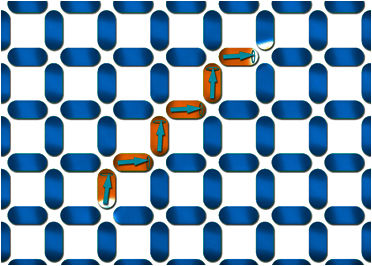Looking for clues in spin ice: Spectral fingerprint of magnetic monopoles discovered
Advertisement
An international team of researchers including scientists from Jülich have proposed a new method to identify and analyse exotic material properties in certain nanostructured magnets using experiments. The researchers hope that this will allow such properties in artificial spin-ice materials to be detected more easily, which could be used one day to develop novel logic elements for data processing.

Monopole-antimonopole structure (orange) in an artificial spin-ice lattice composed of magnetic elements (blue).
S. Gliga / Argonne National Laboratory
Spin-ice materials possess unusual properties. For example, magnetic monopoles and antimonopoles can form within them in pairs connected via strings of magnetic elements. The physicists used computer simulations to show that such magnetic structures in artificial spin ice can be identified by characteristic oscillations in the microwave range. Like a fingerprint, the oscillations tell us about the occurrence of monopoles and their frequency in the sample being investigated. The oscillations can be initiated by exciting the samples using magnetic field pulses, for example, or laser pulses.
As the monopole structures can be selectively positioned and moved in the artificial spin ice, the researchers propose using them to design novel logic elements in which magnetic waves will flow instead of electric charges. The monopole structures in these logic elements would have a function similar to a breakwater, which controls the propagation of waves. Using techniques such as lithography, artificial spin-ice materials can be made up of engineered nanoscale areas that are small enough to function as single magnetic elements.
Original publication
Other news from the department science

Get the chemical industry in your inbox
By submitting this form you agree that LUMITOS AG will send you the newsletter(s) selected above by email. Your data will not be passed on to third parties. Your data will be stored and processed in accordance with our data protection regulations. LUMITOS may contact you by email for the purpose of advertising or market and opinion surveys. You can revoke your consent at any time without giving reasons to LUMITOS AG, Ernst-Augustin-Str. 2, 12489 Berlin, Germany or by e-mail at revoke@lumitos.com with effect for the future. In addition, each email contains a link to unsubscribe from the corresponding newsletter.
































































